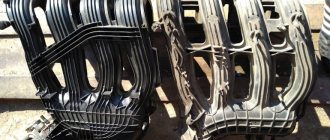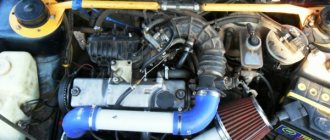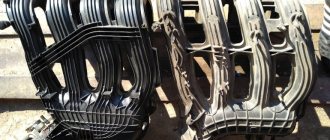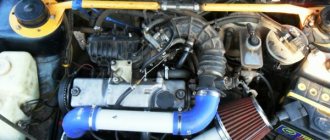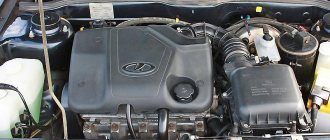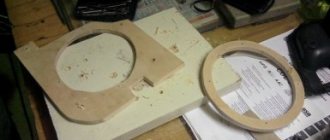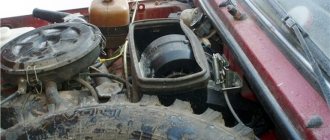April 23, 2019 Lada.Online 69 676 0
One of the owners of Lada Priora decided to do engine tuning by installing a receiver (intake module) from a 1.8-liter VAZ 21179 (from Lada XRAY or Lada Vesta, article number 21177-1008600-00) on the 1.6-liter VAZ 21126 engine. He determined the effectiveness of such modification in several ways.
Why was the receiver from VAZ 21179 chosen?
:
- it is as similar as possible to the VAZ 21126 receiver;
- it is plastic, which means it will not heat the intake air so much, which will have a positive effect on the filling as a whole;
- According to numerous tests, he showed the results of almost TOP receivers.
TEST No. 1
For maximum accuracy, measurements were taken on one day. First on a standard receiver, then it was replaced with a 21179 receiver, and again for tests. The test results are presented in the graph (black – receiver 21126; red – receiver 21179):
https://www.drive2.ru/users/stmel/
Neither Cycle Filling (CN) nor Mass Air Flow (MAF) have changed much. The central frequency has only shifted a little to the top (4500-7000 rpm), and this is logical, because compared to the standard receiver, the channels of the 21179 receiver are slightly shorter (460 MHz at 4600 rpm and 5200 rpm, respectively). The owner believes that the lows (XX-2500 rpm) and the middle (2500-4500 rpm) remained the same, both in terms of graph and feel. But at the top the car rides more confidently.
Conclusion
- Receiver 21179 showed itself better than 21126, as an alternative to the standard one - this is an excellent option.
- Receiver 21179 is not a sports receiver as it is presented in tests.
- The appropriate price for the 21179 receiver is 3,500 rubles (now it is sold for 5,000 rubles).
- With the receiver 21179 the response to pressing the gas pedal has become clearer. When you lightly press the gas pedal, the traction has become better (you can feel the acceleration, there is no need to press the pedal harder as before), the top has become brighter.
Where can I buy?
Receiver 1.8 and other accessories at the lowest prices are presented in our online store.
Let us remind you that we previously talked about inexpensive tuning of the VAZ 21179 engine, which allows you to increase power by 13%.
Keywords: Lada Vesta engine | lada xray engine | Lada Largus engine | Lada Granta engine | Lada Kalina engine | Lada Priora engine | universal article
0 0 0 0 0 0
Share on social networks:
Reasons for replacing the Lada Priora receiver
There are a considerable number of varieties of intake manifolds, for example, made from various types of metals or composite materials. However, the Priora receiver is made entirely of plastic. This material prevents excessive heating of the manifold due to a hot car engine.
Thus, the air flow characteristics are improved, which has a positive effect on the proportions and quality of the air-fuel mixture. However, plastic also has a main, negative side - fragility. As a result, numerous breakdowns occur both due to the fault of the car owner and due to low temperatures at which the plastic loses its strength coefficient.
The most common damage can be caused by: - road traffic accidents (even minor ones); — accidental impacts during any repair work in the engine compartment; — other reasons;
If the receiver on your car has through holes or any other leaks, then it must be repaired (if possible) or replaced. If a part is faulty, air loss will occur, resulting in improper engine operation.
Malfunctions, causes, elimination
Since the 21126 engine is a 16-valve front-wheel drive design with an overhead camshaft position, it is prone to characteristic breakdowns:
| No startup when crankshaft rotates | 1) ignition coils are faulty 2) failure of electronic control 3) DPKV breakdown 4)fuel system malfunction | 1) Repair or replacement 2) flashing or replacing controllers 3) replacing the crankshaft position sensor 4) replacing the pressure regulator, cleaning the fuel module, injectors and ramp |
| The engine won't start | 1) cold 2) warmed up | 1) recharging the battery, cleaning the power system, replacing the coolant temperature sensor, replacing injectors, repairing the fuel management system 2) in addition to the above, replacing the air filter |
| The speed is floating XX | 1) vacuum hose connections 2) cylinder head gasket 3) clogged air filter | 1) replacing or tightening clamps 2)use a new gasket 3) cleaning or replacing the cartridge |
| Misfire in XX mode | 1)low compression 2) injector failure 3) failure of the ignition coils 4) faulty spark plugs | 1) replacing rings; valve stem seals2) installation of new injectors 3)repair or replacement 4) gap adjustment or replacement |
If you follow the requirements of the operating instructions and maintenance regulations, these troubles can be avoided.
Tuning the Priora 126 engine for 20-30 thousand rubles
In the comments they asked a question about Priora. What can be done for 20-30 thousand rubles. with a motor to make it go better.
Let's first consider the situation for 30,000, and then the minimum for 20,000.
For 30,000 you can bore the channels, throw in the shafts , change the throttle valve, injectors and calibrate the engine.
Now let’s look at how much each position costs. First, let's go through the material. 16-valve shafts cost from 6500 and above. I would eventually install some turbo shafts. Because the engine will spin no more than 7000, the engine is quite low and in the future it will seem to you that the increase is not enough, you will get tuning disease and will continue to charge the engine. In order to have the most important foundation for development, you buy turbo shafts, say 9.6, and 10.1 for the intake and exhaust. In principle, a small overlap is very good for a low-end motor. They cost approximately 6800 from the manufacturer. By the exhaust. Install a spider that simply replaces the catalyst. It costs around 1500 rubles. You can also change the throttle valve . It costs about 1000 rubles, with a diameter of 54 for a standard receiver. Further, Bosch 107 injectors cost from 2000 rubles, depending on the store where you buy them. You will also need consumables in the region of 1000 rubles. There are all sorts of gaskets. Valves, light T-shaped ones, cost from 3500 depending on who the manufacturer is. This is all the material you have to buy. Now let's look at the work. Boring of channels starts from about 3500. Removing and installing the cylinder head head and assembling and disassembling it around 5000. You can find it cheaper, it doesn’t require high qualifications. Lay the shafts, i.e. make a cut for cams from 1000 rubles. It is advisable to have a more experienced person do this. Calibrate the motor. Naturally, when you have done all this, bored out the channels, installed valves, exhaust, throttle valve, injectors, now you can tune the engine, otherwise the car won’t really drive, there will be failures with an enriched mixture. In general, calibration costs from 5000. A fairly simple configuration. Don’t skimp on this because the calibrators will determine everything optimally.
Let's consider the option for 20,000 rubles.
We simply bore out the channels and install the spider exhaust we talked about. We change the injectors because the standard ones are not enough in any case. We also take into account work expenses. You need to remove, install, calibrate. Basically everything.
In the first case, the costs were 30,500 rubles, in the second case, 19,000. In the first case, you will get about 140 hp, in the second case, about 120 hp. with normal torque and resource. Also in the first case with shafts. I recommend bottom shafts. There are no sliding gears required. It will be possible to install factory ones if the phases are made a little wider, naturally the ride will be a little better, but there will be costs for sliding gears. Why exactly this motor configuration, why do I recommend doing this? In a sense, you have prepared the foundation and the engine is almost ready. All that remains is to change the piston, intake manifold and install the turbine. If you are not a supporter of turbo, but a supporter of aspirated engines. You just need to change the hard springs, install a normal Opel direct-flow exhaust, a receiver and you will get a motor with more powerful performance. There is a standard Priorovskaya piston. All work was done head on.
Also, for this motor, I would recommend that you change the main pair. At least do some work on the box. Just change the main pair 4.1 or 4.3. Make the gear shorter because the operating speed has increased from 5600 to 6600. Make the gear ratios shorter. The easiest way is to place the main pair. What kind of cars can you make? Well, I think you will do everything with 2-liter naturally aspirated ones. If you want something more, you need to look further. Either make a more angry aggressive atmosphere, or make it more turbo. For atmosphere, of course, the shafts will need to be changed. Put more revving ones.
So that's all in a nutshell. If you have any questions, ask them in the comments. Dispute always gives birth to truth. It is advisable not to insult each other and not to be clever.
I wanted to immediately explain why we are installing a throttle valve of a larger diameter, although it would be logically more correct to install a factory one. The fact is that when you squander the channels, the lows will increase. Naturally, to increase power you need to install a larger damper. Your low end will already be emphasized more than on a regular stock, and the throttle will already emphasize the high end. Why do we install the usual 4.1 spider, which simply replaces the standard spider with a catalyst. Because it is cheap and cheerful and makes the purging better and leaves practically only one exhaust because we install ordinary turbo downstream shafts, which are not critical in terms of exhaust due to the fact that the overlap angles are small. Our complex is completely interconnected. In our case, a bored channel helps to raise the bottom, and narrow phases on the shafts also help to raise the bottom. We align the entire shelf of moments. The factory receiver to the bottom also remains, the regular exhaust is matched to the shafts. In principle, the motor turns out to be quite good. That's why I recommended all of these positions. Another advantage of turbo shafts is that they can always be sold. Nowadays turbo has become very fashionable. If you sell atmospheric shafts, then there is better, but there is walking. The turbo shafts are all more or less the same in principle. There are not many of them on sale, and they are in demand.
Pros and cons
The new power drive initially has a number of advantages:
- torque is increased, not only in the high speed range, but also at the bottom;
- oil pump performance has been doubled;
- camshafts are lighter, valve cross-section is increased;
- The displacement and engine power have changed significantly - 1.8 liters and 122 liters. pp., respectively;
- a phase distributor appeared on the intake camshaft;
- the intake and exhaust tracts have been improved, Euro-5 standards have been met;
- it is possible to finalize it to the Euro-6 protocol, planned for 2020.
Phase distributor
Exhaust tract
To replace the timing belt, it is necessary to remove half of the equipment under the hood. We come across defective valves from the German manufacturer Mahle, whose production facilities are actually located in China. Hence the increased oil consumption to 3 l/1000 km, then the cylinder head is replaced, which is very expensive (overhaul instead of maintenance).
Oil pump GMB
The use of high-quality parts from foreign manufacturers is not as clear as the designers intended:
- at any time after the European Union imposes sanctions against the Russian Federation, supplies may stop unilaterally;
- domestic industry is not yet able to provide such manufacturing precision;
- the engines will be equipped with a ShPG, low-quality timing belts and rollers, the service life will immediately decrease by half, that is, to 70 - 80 thousand kilometers.
Automatic tensioner
AvtoVAZ remains practically the only manufacturer in the world that, in principle, cannot provide the necessary precision in the manufacture of parts, which is why selective assembly is used on the assembly line, which indicates not advanced, but extremely poor technologies. It is easier for designers to “force the machine” to distinguish between the accuracy class markings of connecting rods and crankshaft main journals and bearings than to strictly adhere to one accuracy class, as in the entire civilized world.
Crankshaft 21179
Featured Posts
Good day.
The client installs a direct-flow exhaust and an enlarged tuning receiver on the Priora. Although the engine hardware will not be redesigned.
The question is this. What calibrations in Chiptuner 7 need to be adjusted for the increased volume of the receiver? ECU Bosch 7.9.7+ engine 1.6 16kl
If anyone can give me some advice.
Modified on January 11, 2012 by kirill726
Well, finally a competitor has appeared in my city
Sergey, now you’ll have to get up earlier for work......lyrics..
The author doesn’t need any prior receiver and doesn’t need to edit anything, it’s not the right block.
But don’t Vit, with such knowledge of a competitor for five years I can still sleep peacefully
I know this very well myself. Simplicity: the client has stuck to his guns and doesn’t want to understand anything. The engine is stock, the ECU is BOSCH, there is no sense in the receiver.
And as far as competition is concerned, there is enough work for everyone. Moreover, my workshop is in Armavir.
As far as I understand Sergei Fedorenko????
Since the client is stubborn, let him run the stock firmware))) or edit it himself
It’s just that there is January, but the client doesn’t feel sorry for the money for it, although it’s easier to set up.
It’s just that there is January, but the client doesn’t feel sorry for the money for it, although it’s easier to set up.
From personal experience, such clients will then get bored))) this is not this, then this is not that...
Kirill, I know where you are, but the mistakes are unforgivable... we need to catch up.
Get rid of such clients, otherwise it will be a problem for you...
Modified on January 11, 2012 by SergeyF
Sergey, I can also tell from your work.....
Tell me, I’m really curious, did you really redo something after me? It seems that I don’t have a single VAZ that hasn’t been repaired since the days of carbs.
A lyrical digression - recently Kalina was diagnosed with Yubileiny - it’s impossible to fix!
Modified on January 11, 2012 by SergeyF
He who does not work is not mistaken.
You will make a machine, for example, on ignition, and the next day his DF will die.....
Of course, this also happens, but there would be no need to pour RD08 software into the M73 into the previous hardware with the 95080 seal... it was wobbling at XX, the seven almost lost the engine until it crawled, and it’s also not worth pouring what was flooded there.
Modified on January 11, 2012 by SergeyF
Good day.
The client installs a direct-flow exhaust and an enlarged tuning receiver on the Priora. Although the engine hardware will not be redesigned.The question is this. What calibrations in Chiptuner 7 need to be adjusted for the increased volume of the receiver? ECU Bosch 7.9.7+ engine 1.6 16kl
If anyone can give me some advice.
From the exhaust it is more or less clear what kind of receiver it is. Increased volume is not an indicator, which one exactly? And I’ll tell you approximately what your client will get as a result.
He won't get anything from Bosch
He won't get anything from Bosch
What did Bosh do wrong?
Math model and lack of visibility of the necessary calibrations
Good day.
The client installs a direct-flow exhaust and an enlarged tuning receiver on the Priora. Although the engine hardware will not be redesigned.The question is this. What calibrations in Chiptuner 7 need to be adjusted for the increased volume of the receiver? ECU Bosch 7.9.7+ engine 1.6 16kl
If anyone can give me some advice.
try to twist the flow pulsations, but you need to have information on SS - use
at the same time an alphameter.
Anatoly, here the pulsations are still not an analogue of the cyclic correction..., there’s nothing special there
Math model and lack of visibility of the necessary calibrations
For such tuning you don’t need a lot of calibrations
General information and piston design
The purpose of the piston is to transfer the energy produced by the combustible mixture to the crankshaft. When combustion products expand, enormous loads are placed on the surface of the part. The maximum pressure in this case can be 80 bar, and this is comparable to a force of several tons.
The temperature in the cylinders during combustion of the mixture can reach 2,600 degrees, which is several times higher than the temperature at which the piston melts. As a result, at this moment the strength of the alloy decreases, and thermal stress occurs along the surface of the element due to the temperature difference. In order for the piston to function under such harsh operating conditions, it must not only be lightweight, but also sufficiently resistant to wear. In addition, a high-quality forged group of pistons must also have a high thermal conductivity, which will allow the elements to quickly cool when operating at high temperatures.
As for the surface itself, it must be formed in such a way that the piston does not jam in the cylinder under any circumstances. Otherwise, hot gases may enter the crankcase. Since the components are barrel shaped as you can see in the photo, even a large temperature difference between the bottom and skirt will not affect its functionality. It should also be noted that these parts are produced using an “anti-ellipse”, which makes it possible to compensate for the deformation of the skirt.
The top element of the pistons is the head, which consists of a bottom and grooves through which the seal rings are installed. The head should be more reliable, since most of the loads fall on it. Therefore, the piston heads are treated with an additional protective coating. The grooves for the O-rings themselves are made at a slight angle, as a result of which the outer edges of the rings will be slightly higher than the inner ones. As a result, the slope of the cross-section of the groove will not appear, and this is quite possible.
To make the piston slide better, its surface is also opened with additional materials. For greater break-in, the manufacturer usually uses phosphating or tin, which also reduces the likelihood of scratches when starting a cold engine. But such a coating usually wears out during running-in. Another coating - anti-friction - remains for the entire service life, it helps prevent the appearance of rust and erosion on working surfaces.
The piston skirt must be processed with special cutters to ensure the creation of microrelief. This way, the motor lubricating fluid will adhere better to the surface of the element, and the friction will be much less. So what are the best pistons to put on your car?
You will choose the manufacturer yourself, but on our own behalf we would like to add that all of the above requirements are met by the companies’ products:
Receivers for 16-valve engines
Air is one of the most important substances for a car, since fuel detonation is impossible without it.
And for sports cars it is even more important. To solve this problem, the Timeturbo store offers a wide range of receivers for 16-valve power plants. We sell high-quality and certified parts that have manufacturer approvals. The intake system of a sports car is designed to supply as much of the combustible mixture as possible into the combustion chamber. If the valve is open, air is sucked in and quickly moves towards the cylinder head, but when it closes suddenly, it stops and creates an area of high pressure, the wave of which returns upward. At a certain manifold length, it bounces back to the valve and helps open it for the next cycle, thereby helping to squeeze the fuel mixture into the cylinders.
Thus, installing receivers on 16-valve engines allows you to: • optimize valve timing; • improve cylinder filling; • speed up car acceleration.
In our catalog you can choose original receivers in a wide price range. To order a part, just add the selected model to your cart and follow the further instructions. In addition, applications are also accepted by telephone at 8 800-2228-163 in Tolyatti.
Instructions for replacing valves
Once you have removed the cylinder head, you need to place it on a wooden backing. This will allow you to protect the valves from damage. Then remove and replace according to the instructions:
- Remove the 20 screws holding the camshaft bearing block in place - you will need a size 8 wrench to do this.
- Remove the shafts and seals located at their front ends.
- Remove the plugs from the ends of the cylinder head.
- Remove the hydraulic pushers.
- Clean the surface of the head so that you can work with it comfortably.
- Place a stop under the valve to be removed. There is a good way to locate the puller: screw the bearing cap fixing bolt into the hole in the head housing. You need to hook the puller onto this bolt.
- Squeezing with a puller, remove the valve crackers from the upper spring plate - this can be done with tweezers or carefully pry them off with a screwdriver. If the crackers are difficult to remove, use a mallet (or rubber mallet) to lightly hit the top plate. After this, disassemble the puller structure.
- Remove the top plate and spring.
- Pry the valve with a screwdriver to remove it from the seat. Carry out similar work with the remaining elements; you will need to remove all 16 parts sequentially.
- Using a special puller, remove the oil seals from the valves. Clean any carbon deposits from the valve so that you can visually assess its condition.
What will installing a 1.8 receiver on a 1.6 engine in LADA give?
One of the owners of Lada Priora decided to do engine tuning by installing a receiver (intake module) from a 1.8-liter VAZ 21179 (from Lada XRAY or Lada Vesta, article number 21177-1008600-00) on the 1.6-liter VAZ 21126 engine. He determined the effectiveness of such modification in several ways. Why was the receiver from VAZ 21179 chosen?
:
- it is as similar as possible to the VAZ 21126 receiver;
- it is plastic, which means it will not heat the intake air so much, which will have a positive effect on the filling as a whole;
- According to numerous tests, he showed the results of almost TOP receivers.
Disadvantages of engine 21179
The first 1.8 21179 engines rolled off the assembly line in 2016. Already after 3 years of use, the disadvantages of the “volumetric” motor are known.
The main drawback, according to the owners based on reviews, is the low engine life. What is the reason for this?
- To supply the phase shifter with engine oil, manufacturers drilled additional channels in the cylinder block, thereby calling into question the possibility of boring blocks to unprecedented repair sizes. For comparison, motorsports drivers bore “prioro” blocks 21126 from 82 mm to 84 mm, while civilian engines bore them to 83 mm. Having bored the engine block to dimensions of 83 mm per cylinder, the likelihood of opening the oil channel becomes high.
- Increased load on the crankshaft journal. Compared to the 21126 or 21129 engine, the crankshaft journal was reduced in diameter. Due to the higher piston stroke than on 1.6 engines, we get additional load on the crankshaft.
- The inserts are a calculation error by the engineers. significantly reduce the resource of the internal combustion engine.
- More complex engine maintenance. To change the timing belt, you need special tools, removing the valve cover, etc.
- Oil burn - The connecting rod and piston group from the factory may not be installed in the correct size. (A frequent problem at AvtoVAZ, I encountered it personally). The way out of this situation is to replace the pistons under warranty (the manufacturer assures that the oil consumption will drop as the engine runs in).
- Another nuance is the use of solid oil scraper rings. The use of these rings under load leads to oil consumption. In other matters, like any 16kL VAZ engine, due to the use of these oil scraper rings, oil is consumed at high speeds.
- Knocking of hydraulic compensators - oil starvation, check the oil level
- The cut-off is 6200 rpm - a little not enough for a comfortable volume; you have to switch at the moment the car is directly ahead of you
Engine oil
5W-30 5W-40 10W-40 15W40
Standard oils for VAZ engines. The replacement period is at least once every 10 thousand km. (advice for the benefit of the motor). When asked which oil is best to fill, there are endless battles, tests and correspondence on forums. People evaluate carbon deposits and other parameters that are incomprehensible to “distant” car enthusiasts
The author adheres to his opinion on this matter: it doesn’t matter what kind of oil, the main thing is that it is original from the factory, and not spilled from a barrel in a neighboring garage. Believe me, in practice, finding original oil is not so easy.
How to remove the receiver on a Priora
Tools that may come in handy: - 10mm socket; - key 13; - screwdriver.
To remove the intake manifold you will need:
- Due to the fact that in the next steps of the instructions there will be manipulations with electrical wiring, it is necessary to remove the negative terminal of the battery.
- The next step is to remove the plastic screen (cover) from the engine housing. This is done so that it does not interfere with your work.
- After which, it is necessary to remove power from the four ignition coils and dismantle them. To do this, pull out the contact chips. Take a 10mm socket (or a wrench of the same size) and unscrew one fastening bolt on each coil. Simply pull the coils upwards using the necessary force. Now they can be removed. There is no need to remove the spark plugs themselves; they will not interfere with removal. On the other hand, it is advisable to take advantage of the situation and check their condition (gap and spark quality).
- Our next task is to dismantle the throttle assembly. The receiver cannot be removed without removing it. To remove the throttle and avoid excess antifreeze leaking out of the cooling system pipes, you need to prepare first (unscrew the cap of the expansion tank with coolant). To remove the throttle, it is necessary to disconnect all the pipes connected to it, including those responsible for the air supply (corrugation) and cooling. In order to remove the assembly itself, you need to unscrew the two fastening nuts with a wrench or a 13mm socket. Now the assembly together with the sealing strip can be removed, and at the same time inspected and, if necessary, cleaned.
- At this point, locate and remove the crankcase ventilation hose. To do this, loosen the tightened clamp using a flat-head screwdriver and pull it towards you.
- The next step is to dismantle the dipstick structure to check the oil level. It is attached to one screw, which must be unscrewed.
- Now the most important thing is to remove the Priora 16 valve receiver. Doing this is not as difficult as it seems. First of all, we need to unscrew the nuts from the three connecting bolts at the junction of the block and the manifold. It is most convenient to work from a repair pit or using a lift, having previously dismantled the underbody protection of the car. After that, you just have to unscrew two additional nuts.
- It's time to move into the engine compartment and unscrew the two special mounting bolts that are located on the right and left of the receiver housing.
- After which the receiver can be carefully removed.
- Depending on the type and configuration of components in your engine, you may need to unscrew, rotate or remove any component that prevents the receiver from being removed (for example, power steering or a generator).
Why is it necessary to change valves and how is their malfunction determined?
The most common reasons for replacement are:
- bending of the rods when the timing belt breaks (occurs on engines with a volume of 1.5 liters and 16 valves, since they did not have special recesses on the pistons);
- wear or deformation of the working surface (burnout) - occurs due to a lean mixture, engine overheating or the use of low-quality components;
- bending of the surface that occurs due to wear of the return spring - in this case, repairs will be more labor-intensive and expensive.
It is important to be able to diagnose problems with the valve system before your Priora stops with a jammed engine. The first signs of wear are:
- drop in engine power;
- knocking during its operation;
- increased oil consumption and the appearance of black smoke from the exhaust pipe;
- Unstable operation of the power unit at idle.
The problem is that these signs are not obvious. They appear with various problems with the Priora engine. It is possible to determine that it is the valves that have become unusable after disassembling and diagnosing the motor. To carry out troubleshooting, it is necessary to remove the block head, only after this you can determine whether the elements will need to be replaced or not.
TEST No. 2
Acceleration was measured using a special Drag-On device. As a result of the races, a table of measurements was compiled on different configurations (the last measurement on the receiver was made on light forged wheels, all the rest on conventional stamping):
https://www.drive2.ru/users/stmel/
On the standard receiver, acceleration to 100 mph was 9.2 seconds, on the 21179 receiver - 9.1 seconds (different disks could affect the result). A noticeable difference is felt at a distance of 400 m. Receiver 21126 - 16.5 seconds, and on 21179 - 16.0 seconds.
Installing a receiver on a Priora
As usual, installation is carried out in the same way as removal, however, during its production you must be extremely careful not to damage the receiver body. It is extremely important to insert the installed part with the holes into the connecting pins of the cylinder block, after which the manifold is directed to the mounting points on the engine.
Small but important points for installation:
- always clean or lubricate the rubber seals installed at the points of contact between the receiver and the cylinder block;
- Properly tighten the nuts at the joints of the elements.
What you need to prepare for repairs
To successfully remove all mechanisms, you must have a set of tools on hand, including:
- set of socket wrenches;
- special pullers for valve springs;
- screwdrivers of different sizes;
- pullers for valve stem seals;
- cylinder head gasket;
- tweezers;
- new spare parts and components, including oils and gaskets.
Valves on a Priora only need to be replaced as a set; they are sold as a complete set so that the car enthusiast can completely update the mechanism. If you only replace one valve, you will soon have to disassemble it to update the others. It is best to do this work at once.
TEST No. 3
Another Priora owner also decided to check the cyclic filling of receivers 21126 and 21177, all other things being equal.
https://www.drive2.ru/users/alexei2878225/
The chart comments like this:
Somewhere one is in the lead, somewhere else. But in general, we can talk about increasing power, because The peak torque moved to 300 rpm. 21126 98 hp, max torque at 4500, 21127 max torque at 4800.
Which receiver is better for Priora?
There is no clear answer to this question. Each situation is individual. However, some comparisons can be made between receivers made of plastic and aluminum.
Advantages of aluminum products:
- higher strength and wear resistance;
- increased engine power due to design features and a larger volume of supplied air;
- Some models are easier to install and therefore easier to remove.
In addition, the shape of the collector itself plays an important role in ensuring increased power, which should not contain sharp corners and transitions. The most important difference between plastic and metal is the strength and durability of the latter. Therefore, we can recommend installing metal types of intake manifolds for Lada Priora cars.
About the modification of the collector
Tuning the VAZ intake receiver is a very popular topic. This operation has two directions. This is the refinement of the inner surface and overcoming the negative influence of the element’s shape. If the latter is asymmetrical, then most of the air will enter the first cylinder, and less and less oxygen will penetrate into all subsequent ones. But symmetrical also has disadvantages. Here the air will enter in the greatest quantity into the middle cylinders. Modifications to the VAZ-2114 intake receiver in this case consist of replacing the standard manifold with a multi-throttle intake system. Here the air flows no longer depend on each other. Accordingly, the same amount of oxygen enters each cylinder.
You can modify the intake receiver of the VAZ-2112 in another way. So, some grind the inner surface. By eliminating some of the highs and irregularities, you can ensure a more uniform air supply to the engine. But as practice shows, this modification does not bring a significant increase in power. A more effective solution is to install chokes. However, this should only be done when installing a turbine, otherwise tuning will not be justified.
What is a receiver for?
In fuel-injected cars, the air travels a long way before entering the combustion chamber. The order of its movement looks like this:
3) Nozzle with mass air flow sensor (MAF).
5) Throttle assembly with damper.
The most important and expensive in this set is the mass air flow sensor. It determines the amount of air that has entered the engine. Based on its readings, the on-board computer regulates the opening time of the injectors, according to the configured setting. This creates an optimal air-fuel mixture. The throttle assembly opens and closes the air flow to increase and decrease rpm. A correctly installed receiver divides the total flow into sleeves, sending identical jets to each of the cylinders.
What kind of engines will be under the hood of the Lada Vesta and technical characteristics of the units
The power line of five-door domestic cars consists of four-cylinder light-fuel internal combustion engines with a volume of 1.6 and 1.8 liters.
Motor VAZ-21127
Finding out what engine is in the Lada Vesta is easy. For example, the unit under the symbol VAZ-21127 is already familiar to our motorists:
- Power – 106 hp.
- Optimal power speed is 5,800 rpm.
- Torque – 148 Nm.
- Maximum torque speed – 4,200 rpm.
The former “Prior” engine was modernized, a controlled air intake system appeared. Its essence lies in a new receiver, where there are controlled dampers that are responsible for its volume when the engine speed changes. The elasticity of its operation is ensured by the fact that at low speeds air enters it through a long channel, and at high speeds through a short channel.
Car owners operating this unit pay attention to the fact that the timing belt requires special attention and timely replacement. To be fair, it is worth noting that there are no problems with floating speed due to the installation of temperature and air pressure sensors instead of the air mass flow controller
Motor VAZ-21179
To begin with, it must be said that the new VAZ development is a modernization of the above-described engine with index 21127. The project itself was worked out in detail a long time ago, but the concern’s management did not support it at the first stage. Nevertheless, its mass production started in 2016.
In terms of power and technical characteristics, the new Lada Vesta engines exceed their basic version:
- Performance – 122 hp.
- Torque – 170 Nm at 3750 rpm.
- Average fuel consumption is 6.8 liters per 100 km.
- Compression ratio – 10.3.
Only at first glance there is nothing interesting in the new product. Even a novice tuner who has just installed a 4-2-1 spider or a window closer thinks so. Therefore, it is worth focusing on the main stages of modernization.
Product delivery options
Note! Below are the shipping methods available specifically for this product. Payment options may vary depending on the shipping method. Detailed information can be found on the “Delivery and Payment” page.
Parcel by Russian Post
Available payment methods:
- Cash on delivery (payment upon receipt)
- Using cards Sberbank, VTB, Post Bank, Tinkoff
- Yandex money
- QIWI
- ROBOKASSA
Shipping throughout Russia. Delivery time is from 5 to 12 days.
Parcel by Russian Post 1st class
Available payment methods:
- Cash on delivery (payment upon receipt)
- Using cards Sberbank, VTB, Post Bank, Tinkoff
- Yandex money
- QIWI
- ROBOKASSA
Shipping throughout Russia. Delivery time is from 2 to 5 days. More expensive than regular delivery by Russian Post, approximately 50%. Parcel weight up to 2.5 kg
Express Parcel EMS
Available payment methods:
- Cash on delivery (payment upon receipt)
- Using cards Sberbank, VTB, Post Bank, Tinkoff
- Yandex money
- QIWI
- ROBOKASSA
Shipping throughout Russia. Delivery time is from 3 to 7 days. More expensive than regular delivery by Russian Post, approximately 100%.
What to pay attention to when reassembling the mechanism
Before installation, the new valve should be lubricated with clean engine oil to improve assembly quality. Assembly must be carried out in the reverse order; after you have assembled the valve system, you will need to install the cylinder head back. Please note that the gasket between the head and the cylinder block is a disposable component - you will need to install a new one. Take the option that immediately comes complete with heat-resistant sealant.
Before installing the head on the block, it is necessary to place the shafts (crankshaft and camshaft) in the TDC position, at which the valves of the first cylinder are closed. To fix the cylinder head bolts, you need to use a torque wrench to control the force. They are tightened in 4 stages:
- broaching with a moment of 20 N*m;
- then repeated force with a moment from 69.4 to 85.7 N*m;
- turning 90 degrees;
- final tightening another 90 degrees.
Only with this approach will the fixation be strong and the screws will withstand use. This wrench and step-by-step approach can also be used to secure the bearing block.
In general, replacing valves is not a difficult task; you can do it yourself, but it requires a scrupulous approach and extreme care. To carry out such repairs less often, monitor the condition of the timing belt and the quality of the fuel being poured. With constant use of bad gasoline, the valves quickly burn out.
